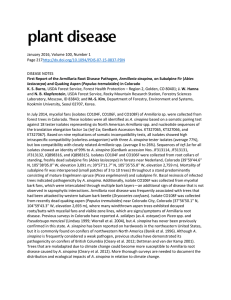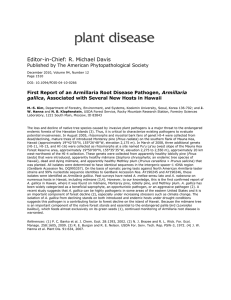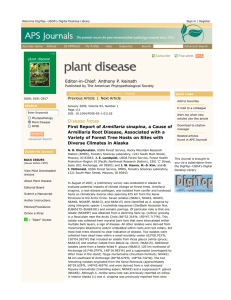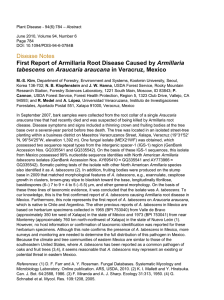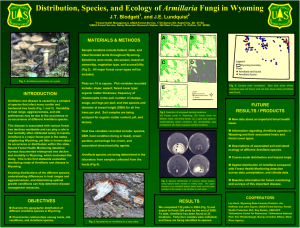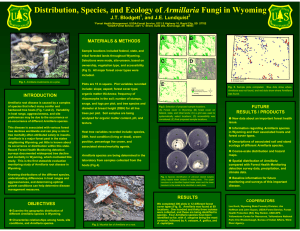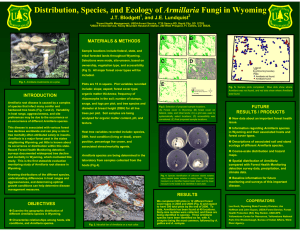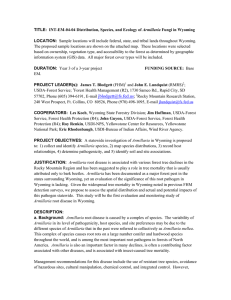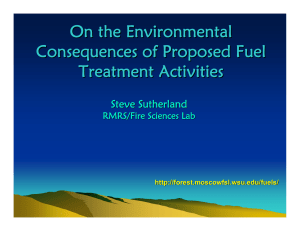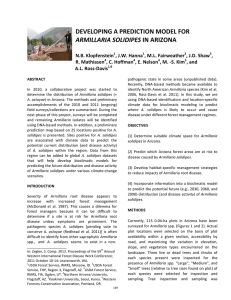Armillaria potential impacts of climate change
advertisement
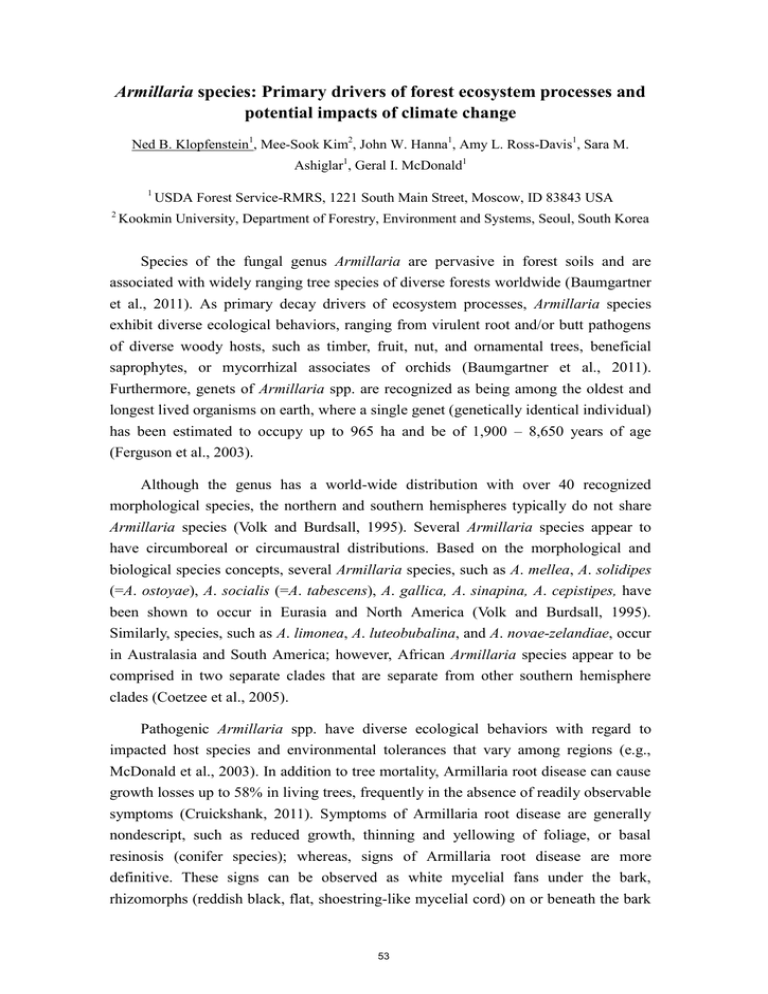
Armillaria species: Primary drivers of forest ecosystem processes and potential impacts of climate change Ned B. Klopfenstein1, Mee-Sook Kim2, John W. Hanna1, Amy L. Ross-Davis1, Sara M. Ashiglar1, Geral I. McDonald1 1 2 USDA Forest Service-RMRS, 1221 South Main Street, Moscow, ID 83843 USA Kookmin University, Department of Forestry, Environment and Systems, Seoul, South Korea Species of the fungal genus Armillaria are pervasive in forest soils and are associated with widely ranging tree species of diverse forests worldwide (Baumgartner et al., 2011). As primary decay drivers of ecosystem processes, Armillaria species exhibit diverse ecological behaviors, ranging from virulent root and/or butt pathogens of diverse woody hosts, such as timber, fruit, nut, and ornamental trees, beneficial saprophytes, or mycorrhizal associates of orchids (Baumgartner et al., 2011). Furthermore, genets of Armillaria spp. are recognized as being among the oldest and longest lived organisms on earth, where a single genet (genetically identical individual) has been estimated to occupy up to 965 ha and be of 1,900 – 8,650 years of age (Ferguson et al., 2003). Although the genus has a world-wide distribution with over 40 recognized morphological species, the northern and southern hemispheres typically do not share Armillaria species (Volk and Burdsall, 1995). Several Armillaria species appear to have circumboreal or circumaustral distributions. Based on the morphological and biological species concepts, several Armillaria species, such as A. mellea, A. solidipes (=A. ostoyae), A. socialis (=A. tabescens), A. gallica, A. sinapina, A. cepistipes, have been shown to occur in Eurasia and North America (Volk and Burdsall, 1995). Similarly, species, such as A. limonea, A. luteobubalina, and A. novae-zelandiae, occur in Australasia and South America; however, African Armillaria species appear to be comprised in two separate clades that are separate from other southern hemisphere clades (Coetzee et al., 2005). Pathogenic Armillaria spp. have diverse ecological behaviors with regard to impacted host species and environmental tolerances that vary among regions (e.g., McDonald et al., 2003). In addition to tree mortality, Armillaria root disease can cause growth losses up to 58% in living trees, frequently in the absence of readily observable symptoms (Cruickshank, 2011). Symptoms of Armillaria root disease are generally nondescript, such as reduced growth, thinning and yellowing of foliage, or basal resinosis (conifer species); whereas, signs of Armillaria root disease are more definitive. These signs can be observed as white mycelial fans under the bark, rhizomorphs (reddish black, flat, shoestring-like mycelial cord) on or beneath the bark 53 of roots/lower stem and in surrounding soil, and/or honey-colored mushrooms, which are produced only sporadically during the favorable season (Fig. 1). To develop management approaches for Armillaria root disease, a first step is to identify which Armillaria species are present or potentially present on sites of interest. Currently, phylogenetic analysis, based on DNA sequences, is among the most effective and cost-efficient tools to identify Armillaria species (e.g., Ross-Davis et al., 2012a; Fig. 2). Surveys and biological sampling (rhizomorphs, mycelial fans, rotten wood, and fruiting bodies) are also critical to understand the geographic distribution of each Armillaria species and the distribution of impacted host tree species. After sufficient data are collected on the geographic locations of each Armillaria spp. of interest, bioclimatic modeling can be used to predict geographic areas that have suitable climate space (the geographic area that is climatically suitable for a particular species’ survival) for the root disease pathogen, and predict areas at risk for Armillaria root disease (Klopfenstein et al., 2009). Although the genus Armillaria has a very wide host range, each Armillaria species exhibits varying impacts depending on host species and climate. In a general sense, pathogenic Armillaria spp. have a greater impact on stressed trees and trees that are maladapted to the site. For this reason, negative impacts of Armillaria root disease are predicted to increase under climate change as more trees become maladapted to current and future climates (e.g., Kliejunas, 2011; Sturrock et al., 2011). The suitable climate space of Armillaria and its host species, as well as potential impacts of Armillaria root disease, can be predicted under various projected climate-change scenarios. Armillaria root disease is expected to increase within geographic areas where climate is predicted to remain suitable for the pathogen, but less suitable for the host. For example, Fig. 3 illustrates the current and future distribution for the pathogenic A. solidipes and Douglas-fir (Pseudotsuga menziesii) in the interior northwestern forests of the USA. In this example, an increase in Armillaria root disease is expected in year 2060, due to decreased availability of suitable climate space for Douglas-fir (Rehfeldt et al., 2006; Fig. 3D) coupled with consistent availability of suitable climate space predicted for A. solidipes (Fig. 3B). Armillaria root disease is not easily managed because pathogens are pervasive and long-term inhabitants of the forest site. A preferred management approach is to favor tree species that are more tolerant of the disease, and well adapted to the site under current and future climates. Other management methods, such as inoculum reduction and biological control, have generated mixed results, depending on the site (e.g., Fox, 2000; Vasaitis et al., 2008). Ongoing studies are examining the genome and transcriptome (expressed genes) of Armillaria spp. (Baumgartner et al., 2011; 54 Ross-Davis et al., 2012b). Such high-powered genetic tools should provide insight into the genetic interactions among hosts, pathogen, and other components for the biotic and abiotic environment. As these interactions become better understood, management techniques will become further refined to mitigate damage cause by Armillaria root disease. Keywords Root disease; climate change; forest disease; bioclimatic modelling; phylogenetics Figures and Tables A C B D E Fig. 1 Symptoms and signs of Armillaria root disease. (A) Mortality and growth loss of Douglas-fir (Pseudotsuga menziesii) within an Armillaria-root-disease center. (B) Basal resinosis of Douglas-fir with Armillaria root disease. (C) Mycelial fan of Armillaria solidipes located under the bark of an infected host tree. (D) Fruiting bodies (basidiomata or mushrooms) of A. solidipes. (E) Rhizomorphs (reddish black, flat, shoestring-like mycelial cord) of A. solidipes found on or beneath the bark of roots/lower stem and in surrounding soil. 55 Fig. 2 Example of a phylogenetic tree of North American Armillaria spp. that is useful for species identification; a 50% majority-rule from Bayesian analysis of the translation elongation factor 1-alpha gene (Ross-Davis et al. 2012a). 56 Contemporary Climate Projected Climate - Year 2060 Pathogen - Armillaria solidipes Pathogen - Armillaria solidipes B A Idaho, USA Idaho, USA from: Klopfenstein et al. 2009 Host - Douglas-fir (Pseudotsuga menziesii) Host - Douglas-fir (Pseudotsuga menziesii) D C Idaho, USA from: Rehfeldt et al. 2006 Idaho, USA Fig. 3 Example of bioclimatic modeling of suitable climate space for pathogen (Armillaria solidipes) and host (Douglas-fir, Pseudotsuga menziesii). On left: predicted suitable climate space of (A) pathogen and (C) host under the current climate. On right: predicted suitable climate space for (B) pathogen and (D) host under modest future climate-change scenario for year 2060 (CGCM3 GCM (Canadian Centre for Climate Modeling and Analysis, SRES A1B). Red color = geographic areas with the highest probability of having suitable climate space; other colors = lower probability of suitable climate space; and no color = low probability of suitable climate space. Under future climate change scenarios, Armillaria root disease is expected to increase in areas where the pathogen is well adapted and the host is maladapted. 57 References [1] Baumgartner, K., Coetzee, M. P. A., Hoffmeister, D. 2011. Secrets of the subterranean pathosystem of Armillaria. Mol. Plant Pathol. 12:515-534. [2] Coetzee, M. P. A., Wingfield, B. D., Bloomer, P., Wingfield, M. J. 2005. Phylogenetic analyses of DNA sequences reveal species partitions amongst isolates of Armillaria from Africa. Mycol. Res. 109:1223-1234. [3] Cruickshank, M. G. 2011. Yield reduction in spruce infected with Armillaria solidipes in the southern interior of British Columbia. Forest Pathol. 41:425-428. [4] Ferguson, B. A., Dreisbach, T. A., Parks, C. G., Filip, G. M., Schmitt, C. L. 2003. Coarse-scale population structure of pathogenic Armillaria species in a mixed-conifer forest in the Blue Mountains of northeast Oregon. Can. J. Forest Res. 33:612-623. [5] Fox, R. T. V. (ed.) 2000.: Armillaria Root Rot: Biology and Control of Honey Fungus, R. T. V. Fox, (ed.). Intercept Limited, Andover, UK. 222 p. [6] Kliejunas, J. T. 2011. A risk assessment of climate change and the impact of forest diseases on forest ecosystems in the western United States and Canada. General Technical Report PSW-GTR-236, USDA Forest Service, Pacific Southwest Research Station, Albany, CA, USA. 70 p. [7] Klopfenstein, N. B., Kim, M.-S., Hanna, J. W., Richardson, B. A., Lundquist, J.W. 2009. Approaches to predicting potential impacts of climate change on forest disease: An example with Armillaria root disease. Research Paper RMRS-RP-79. USDA Forest Service, Rocky Mountain Research Station, Fort Collins, CO, USA. 10 p. [8] McDonald, G. I., Evans, J. S., Moeur, M., Rice, T. M., Strand, E. K. 2003. Using Digital Terrain Modeling and Satellite Imagery to Map Interactions among Fire and Forest Microbes. In: Proceedings of Fire Conference 2000: The First National Congress on Fire Ecology, Prevention, and Management. K. E. M. Galley, R. C. Klinger, N. G. Sugihara (eds). Miscellaneous Publication No. 13, Tall Timbers Research Station, Tallahassee, FL. pp. 100-110. [9] Rehfeldt, G. E., Crookston, N. L., Warwell, M. V., Evans, J. S. 2006. Empirical analyses of plant-climate relationships for the western United States. Int. J. Plant Sci. 167:1123-1150. [10] Ross-Davis, A. L., Hanna, J. W., Kim, M.-S., Klopfenstein, N. B. 2012a. Advances toward DNA-based identification and phylogeny of North American Armillaria species using elongation factor-1 alpha gene. Mycoscience 53:161-165. [11] Ross-Davis, A. L., Stewart, J. E., Hanna, J. W., Kim, M.-S., Cronn, R. C., Rai, H. S., Richardson, B. A., McDonald, G. I., Klopfenstein, N. B. 2012b. De novo assembly and transcriptome characterization of an Armillaria solidipes mycelial fan. Proc.: 59th Western International Forest Disease Work Conf.. 11-14 Oct. 2011, 58 Leavenworth, WA, USA. USDA Forest Service, FHP, Region 5, Portland, OR. in press [12] Sturrock, R. N., Frankel, S. J., Brown, A .V., Hennon, P. E., Kliejunas, J. T.; Lewis, K. J., Worrall, J. J., Woods, A. J. 2011. Climate change and forest diseases. Plant Pathol. 60:133-149. [13] Vasaitis, R., Stenlid, J., Thomsen, I. M., Barklund, P., Dahlberg, A. 1998. Stump removal to control root rot in forest stands: a literature study. Silva Fenn. 42:457-483. [14] Volk, T. J., Burdsall, H. H., Jr. 1995. A Nomenclatural Study of Armillaria and Armillariella species. Synopsis Fungorum 8. Fungiflora, Oslo, Norway. 121 p. 59
